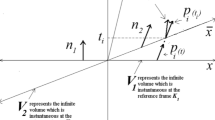Abstract
We study the question of conditions for the existence of negative-energy states of particles in the absence of external fields in inertial and noninertial frames of reference. We show that in the nonrelativistic case in noninertial reference frames, there always exist domains where the energy of particles is negative. We also show that in the relativistic case, the existence of negative-energy states of point particles does not lead to violations of the energy dominance condition. We consider conditions for the appearance of negative and zero energies of particles in the Milne universe and Rindler space–time.

Similar content being viewed by others
References
L. D. Landau and E. M. Lifshitz, Mechanics, Pergamon Press, Oxford (1976).
R. Penrose, “Gravitational collapse: The role of general relativity,” Rivista Nuovo Cimento, Num. Spec. I, 252–276 (1969).
D. Christodoulou and R. Ruffini, “Reversible transformations of a charged black hole,” Phys. Rev. D, 4, 3552–3555 (1971).
A. A. Grib, S. G. Mamayev and V. M. Mostepanenko, Vacuum Quantum Effects in Strong Fields, Friedmann Lab. Publ., St. Petersburg (1994).
W. G. Unruh, “Notes on black-hole evaporation,” Phys. Rev. D, 14, 870–892 (1976).
A. A. Grib and Yu. V. Pavlov, “Comparison of particle properties in Kerr metric and in rotating coordinates,” Gen. Rel. Grav., 49, 78, 20 pp. (2017).
C. W. Misner, K. S. Thorne, and J. A. Wheeler, Gravitation, Freeman, San Francisco (1973).
A. A. Grib and Yu. V. Pavlov, “Static limit and Penrose effect in rotating reference frames,” Theoret. and Math. Phys., 200, 1117–1125 (2019); Erratum, 201, 1541–1541 (2019).
S. W. Hawking, “Particle creation by black holes,” Commun. Math. Phys., 43, 199–220 (1975).
L. D. Landau and E. M. Lifshitz, Course of Theoretical Physics, Vol. 2: The Classical Theory of Fields, Pergamon Press, Oxford (1983).
D. A. Kirzhnitz and V. N. Sazonov, “Superluminal motions and special relativity theory [in Russian],” in: Einsteinovskii Sbornik 1973 (V. L. Ginzburg, ed.), Nauka, Moscow (1974).
G. Feinberg, “Possibility of faster-than-light particles,” Phys. Rev., 159, 1089–1105 (1967).
A. Yu. Andreev and D. A. Kirzhnits, “Tachyons and the instability of physical systems,” Phys. Usp., 39, 1071–1076 (1996).
N. N. Bogolyubov and D. V. Shirkov, Quantum Fields, Wiley, New York (1980).
A. A. Grib and Yu. V. Pavlov, “On phase transitions near black holes,” Jetp Lett., 116, 493–499 (2022).
R. C. Tolman, The Theory of the Relativity of Motion, University of California Press, Berkeley, CA (1917).
O. M. P. Bilaniuk, V. K. Deshpande, and E. C. G. Sudarshan, “ ‘Meta’ relativity,” Amer. J. Phys., 30, 718–723 (1962).
E. C. G. Stueckelberg, “Remarque à propos de la création de paires de particules en théorie de relativité,” Helv. Phys. Acta., 14, 588–594 (1941).
R. P. Feynman, “The theory of positrons,” Phys. Rev., 76, 749–759 (1949).
E. Recami and R. Mignani, “Classical theory of tachyons (special relativity extended to superluminal frames and objects),” Riv. Nuovo Cim. (1971–1977), 4, 209–290 (1974).
A. A. Grib, “Is it possible to move backward in time? [in Russian],” Priroda, 4, 24–32 (1974).
M. Jammer, The Concepts of Mass in Classical and Modern Physics, Harvard Univ. Press, Cambridge (1961).
H. Bondi, “Negative mass in general relativity,” Rev. Mod. Phys., 29, 423–428 (1957).
Ya. P. Terletskii, Paradoxes in the Theory of Relativity, Plenum Press, New York (1968).
A. P. Lightman, W. H. Press, R. H. Price, and S. A. Teukolsky, Problem Book in Relativity and Gravitation, Princeton Univ. Press, Princeton (1975).
W. B. Bonnor, “Negative mass in general relativity,” Gen. Rel. Grav., 21, 1143–1157 (1989).
A. A. Shatskii, I. D. Novikov, and N. S. Kardashev, “The Kepler problem and collisions of negative masses,” Phys. Usp., 54, 381–385 (2011).
S. Chandrasekhar, The Mathematical Theory of Black Holes, (International Series of Monographs on Physics, Vol. 69), Oxford Univ. Press, New York (1983).
I. D. Novikov and V. P. Frolov, Physics of Black Holes (Fundamental Theories of Physics, Vol. 27), Springer, Dordrecht (1989).
R. P. Kerr, “Gravitational field of a spinning mass as an example of algebraically special metrics,” Phys. Rev. Lett., 11, 237–238 (1963).
P. Ehrenfest, “Uniform rotation of rigid bodies and the theory of relativity,” in: Relativity in Rotating Frames (Fundamental Theories of Physics book series, Vol. 135, G. Rizzi and M. L. Ruggiero, eds.), Kluwer, Boston (2004), pp. 3–4; P. Ehrenfest, “Gleichförmige Rotation starrer Körper und Relativitätstheorie,” Phys. Z., 10, 918–920 (1909).
S. Weinberg, Gravitation and Cosmology: Principles and applications of the general theory of relativity, Wiley, New York (1972).
E. A. Milne, Relativity, Gravitation and World-Structure, Clarendon Press, Oxford (1935).
Ya. B. Zel’dovich and I. D. Novikov, The Structure and Evolution of the Universe [in Russian], Nauka, Moscow (1975).
G. F. R. Ellis and T. Rothman, “Lost horizons,” Amer. J. Phys., 61, 883–893 (1993).
R. N. Boyer and R. W. Lindquist, “Maximal analytic extension of the Kerr metric,” J. Math. Phys., 8, 265–281 (1967).
N. D. Birrell and P. C. W. Davies, Quantum Fields in Curved Space, Cambridge Univ. Press, Cambridge (1982).
W. Rindler, “Kruskal space and the uniformly accelerated frame,” Amer. J. Phys., 34, 1174–1178 (1966).
A. A. Grib and Yu. V. Pavlov, “Particles with negative energies in black holes,” Internat. J. Modern Phys. D, 20, 675–684 (2011).
Acknowledgments
The authors thank the participants of the MQFT-2022 conference for the discussion of the talk, and D. I. Kazakov for formulating the question that underlies the title of the paper.
Funding
The work was supported by the Russian Science Foundation (grant No. 22-22-00112).
Author information
Authors and Affiliations
Corresponding author
Ethics declarations
The authors declare no conflicts of interest.
Additional information
Translated from Teoreticheskaya i Matematicheskaya Fizika, 2023, Vol. 216, pp. 504–518 https://doi.org/10.4213/tmf10453.
Rights and permissions
About this article
Cite this article
Grib, A.A., Pavlov, Y.V. Can the energy of a particle be negative in the absence of external fields?. Theor Math Phys 216, 1337–1348 (2023). https://doi.org/10.1134/S0040577923090088
Received:
Revised:
Accepted:
Published:
Issue Date:
DOI: https://doi.org/10.1134/S0040577923090088




